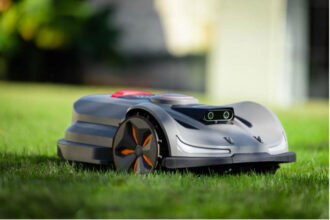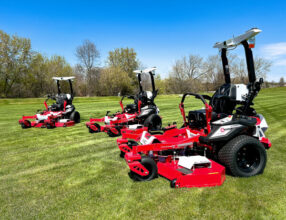2016 OPE Dealer Survey
For the sixth time since 2001, we at Outdoor Power Equipment (OPE) conducted an extensive nationwide survey of outdoor power equipment dealers. This year’s 27-question survey covered a wide range of topics from hourly shop labor and service technician pay rates to annual gross income and social media use. However, unlike the previous five nationwide OPE dealer surveys in 2001, 2006, 2010, 2012 and 2014, we drilled down much deeper with six new questions.
More than 100 OPE dealers took the time out of their busy schedules to complete the survey Aug. 5-12, 2016, and I greatly appreciate their efforts.
Realizing that the answers to a few questions would vary based on region — especially when it comes to hourly shop labor and service tech pay rates — we decided to add further validity to the results of those specific questions by breaking down the responses into the following five regions:
- Northeast: Connecticut, Delaware, District of Columbia, Maine, Maryland, Massachusetts, New Hampshire, New Jersey, New York, Pennsylvania, Rhode Island, Vermont
- South: Alabama, Arkansas, Florida, Georgia, Kentucky, Louisiana, Mississippi, North Carolina, Oklahoma, South Carolina, Tennessee, Texas, Virginia, West Virginia
- Midwest: Illinois, Indiana, Iowa, Kansas, Michigan, Minnesota, Missouri, Nebraska, North Dakota, Ohio, South Dakota, Wisconsin
- Northwest: Alaska, Idaho, Montana, Oregon, Washington, Wyoming
- Southwest: Arizona, California, Colorado, Hawaii, Nevada, New Mexico, Utah
The findings of our survey, along with a few of my own observations, are as follows:
Aging ownership
Based on the previous dealer surveys, dealer feedback and my own observations during my 19 years as editor of OPE, I’ve learned that dealership owners have a tough time of either walking away from their business or finding someone to follow in their footsteps. Unfortunately, I’m afraid that the latter appears to be case, which is why you may have noticed that we have run a series of wealth management articles — including on succession planning — in 2016 and will continue to do so in 2017.
In 2001, approximately one third of OPE dealership owners were 40 to 49 years old, but that demographic has plummeted to less than 12 percent this year. However, many of those owners from 2001 have stuck around as the 60-and-over owners have skyrocketed from about 19 percent in 2001 to a whopping 45 percent this year! For those of you who fall in this age group, you have my sincerest respect and utmost admiration. Incidentally, more than 80 percent of current dealership owners are 50 and over.
Income breakdown
If your dealership has an annual gross income of less than $1 million, you are in the majority as 55 percent fit that criterion.
Approximately 13 percent apiece fall in the $1M-$1,999,999 and $2M-$2,999,999 annual gross income brackets, and 14 percent are members of the $4-million-or-more club.
The majority of dealers indicated at least 70 percent of their business is currently consumer/residential versus about 30 percent commercial. For breakdowns of annual income from the sale of whole goods and annual income from service.
Nearly half of all dealers said their profit margin satisfaction was “fair” and slightly more than a quarter said “good.” On the flip side, less than 1 percent said “very good,” about 16.5 percent said “poor,” and 5.5 percent said “very poor.”
Since 2001, the composition of a dealership’s workforce has remained relatively the same. This year, 45 percent of all dealers said they have 1-5 employees and nearly 47 percent have 1-2 service technicians. Almost 82 percent of all dealers employ up to 4 service technicians and about 94 percent have 1-6 service techs.
Service
I was extremely pleased to see that many of you have gradually increased your shop labor rate and service technician compensation during the past two years.
While dealers charging a shop labor rate of $60-$79.99 has remained nearly the same at about 63 percent, a closer look at the numbers reveals a subtle shift of about 4 percent of dealers who were charging $70-$74.99 in 2014 but are now charging $75-$79.99.
With the slight increase in shop labor rate during the past two years, you have been bumping up the pay of your service technicians accordingly. Slightly more than 80 percent of all starting service technicians are still earning about $9-$16.99 per hour, but those making $13-$14.99 rose slightly from 16.9 to 20.6 percent and those making $15-$16.99 more than doubled from 8.8 percent to 19.6 percent. For the best service technicians, the percentage of dealers paying a minimum of $13 per hour has increased slightly from 89.6 to 92.5 percent. However, those experienced techs making $17-$20.99 has increased 7 percent to 38.8 percent.
Of course, all of these service-related numbers vary by region, so please be sure to check out the charts at the end of this article for your specific region.
Dealers are becoming more selective when it comes to service as about 18 percent said they are only willing to service brands that they sold, which is about a 5-percent increase over 2014. Perhaps that has to do with a drop in warranty payment satisfaction during the past two years with half saying it was “good” or “very good” in 2014 but about 7 percent less indicating that this time around.
Biggest concerns
In 2014 and again this year, we asked dealers which one of the following concerns was their biggest: economy, weather, competition, cost of operating your business, profit margin from sales, availability of quality employees, or other.
The results? In 2014, nearly one out of every four dealers said it was “cost of operating your business.” This year, about 30 percent indicated it was the “availability of quality employees.” On a related note to a separate question, more than 96 percent of dealers indicated that they believe there is a shortage of qualified service technicians for the OPE industry, which would justify the increases in shop labor and service technician pay rates.
Websites and social media
More than three out of every four dealers (77 percent) have a website for their business, nearly two out of every three (64 percent) have a Facebook page and approximately 82 percent use Facebook, which just goes to show you the increasing popularity and widespread use of social media. For a breakdown of other forms of social media used by dealers and how often they use them, please refer to the charts with this article.
Future plans
Since many of you are nearing retirement, most of the new questions in this year’s survey addressed the future, especially the next one to five years.
In the next year, 20 percent of dealers said they plan to add or switch lines and 16.7 percent of dealers said they plan to expand their current location or open a new location, which are both encouraging signs.
However, a staggering 35 percent of dealers said they plan to sell their dealership within the next five years, which I guess should come as no surprise with 45 percent of all dealers being 60 and over. In addition, nearly half of dealers indicated they do have a succession plan for ownership of their business.
Once again, I would like to thank the more than 100 dealers who participated in the survey so that we could validate the results. I hope you are able to take this knowledge, apply it to your own dealership, and become more profitable.






